|
Submit Your "HORROR
STORY" in Which Your Cat Lost One of His Nine Lives - Win
a ScoopFree Automatic Litter
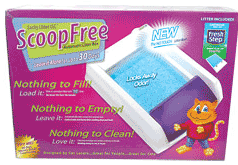 Lucky Litter
LLC, maker of the ScoopFree™ automatic litter box
that you can leave alone for up to 30 days per cat, and Animal Radio®
are marking the Halloween season by kicking off a contest seeking
the best "horror story" in which your cat lost one
of his nine lives. Lucky Litter
LLC, maker of the ScoopFree™ automatic litter box
that you can leave alone for up to 30 days per cat, and Animal Radio®
are marking the Halloween season by kicking off a contest seeking
the best "horror story" in which your cat lost one
of his nine lives.
"This contest is in the
playful spirit of the scary stories told around the campfire,"
said Alan J. Cook, president of Lucky Litter. "We want to
hear your favorite story on how your feline proved that cats
indeed have nine lives."
Share your cat's story and
enter the contest, which runs through Oct. 31, by visiting www.scoopfree.com/contest.
Please include a picture of
you and your cat with your entry. Contest Details
Winners, to be announced by
Nov. 17, will receive a free ScoopFree automatic litter box or
a case of six ScoopFree Litter Tray Cartridges if they already
own a ScoopFree. The contest is not valid where prohibited by
law.
The funny details on your cat's
story may be shared with listeners of our promotional partner
Animal
Radio®. Animal Radio® is the "most-listened-to"
pet show according to Arbitron. The show is carried by more than
90 radio stations and reaches 2 million radio listeners every
week. Please be sure to tell us how to pronounce the name of
you and your cat.
The patent-pending ScoopFree
Litter Tray Cartridge comes pre-filled with Fresh Step®
Crystal litter. The crystal litter absorbs the liquids and dehydrates
the solids, providing unbeatable odor control. ScoopFree automatically
rakes and grooms the litter after the cat leaves the box, removing
the solid waste into a trap built into the disposable tray. ScoopFree
is the first litter box you can leave alone for up to 30 days
with one cat or 15 days with two cats, without any scooping,
cleaning or refilling.
ScoopFree is available at selected
PetSmart stores and can be purchased online at PetSmart.com,
Target.com, Amazon.com and Costco.com. For more information on
this major innovation in cat care, visit www.scoopfree.com
ENTER SCOOP FREE CONTEST
 RECENT
Animal
Radio® PODCASTS: RECENT
Animal
Radio® PODCASTS:
Podcast of TIPPI HEDREN on Deadbeat Dad MICHAEL
JACKSON and HGTV's CLIVE PEARSE (1 hour abridged version)
Podcast
of SUPERZOO NEW PET PRODUCTS SPECIAL with DICK VAN PATTEN (Entire
Two Hours)
Podcast of
KINKY FRIEDMAN and FRED WILLARD guest host (1 hour abridged version)
Podcast of
Hollywood Party for the Animals with MAD TV's DEBRA WILSON SKELTON
and KELLY BISHOP - Steve Irwin Tribute (1 hour abridged version)
Podcast
of DICK VAN PATTEN - Dave Waldon (1 hour abridged version)
Next Weekend: Actor Adrian
Zmed
 The
SUMMER-END NEW PET PRODUCTS SPECIAL LIVE FROM WWPIA SUPERZOO,
LAS VEGAS was a sucess. Here are the items that made the
cut. Listen to the show and learn more at The
SUMMER-END NEW PET PRODUCTS SPECIAL LIVE FROM WWPIA SUPERZOO,
LAS VEGAS was a sucess. Here are the items that made the
cut. Listen to the show and learn more at  http://AnimalRadio.com/092306.html http://AnimalRadio.com/092306.html
Top New Products as heard on-air
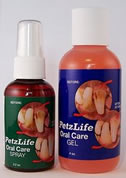 Oral
Care Spray & Gel for Dogs and Cats Oral
Care Spray & Gel for Dogs and Cats
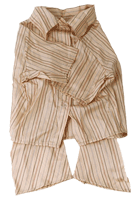 http://www.petzlife.com http://www.petzlife.com
Gidget-Gear
by Tiki - Imaginative
Line of Clothing and Accessories for Pets and their People
http://www.Gidget-Gear.com

Brake-Fast - Dog Food Bowls that Slow Down the Chow
 http://www.Brake-Fast.net http://www.Brake-Fast.net
Epiks - The Best Shoes for your Dog
http://www.Epiks.net

Alexis Creations -
Wedding Attire for Your Pet 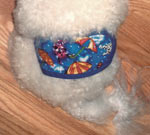 http://www.AlexisCreations.net http://www.AlexisCreations.net
Pants for Dogs
- Protect Your Home
from Dogs Accidents
http://www.PantsForDogs.com
Crunchkins - Edible
Getting Cards for your Dog
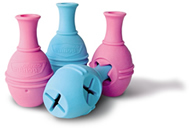 http://www.Crunchkins.com http://www.Crunchkins.com
Canine Genius - Smart Toys for your Dog
http://www.CanineGenius.com
 Skamper
Ramp - The Great Water Escape Ramp Skamper
Ramp - The Great Water Escape Ramp
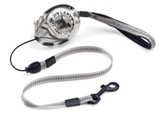 http://www.Skamper-Ramp.com http://www.Skamper-Ramp.com
Planet Dog - Zip Lead Retractable Leash
http://www.PlanetDog.com

Watch Your Step Productions
- Monthly Doos Calendar
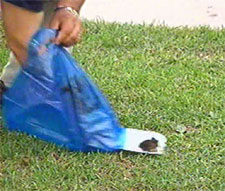 http://www.MonthlyDoos.com http://www.MonthlyDoos.com
A.I.T., Inc. - ScooPick, Bag with a Built-In Scooper
http://www.ScooPick.org
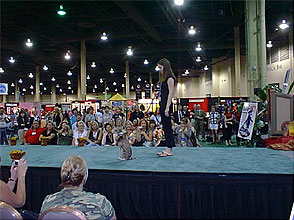
Clothes were definately
the big thing at SuperZoo this year. There was even a fashion
show.
Look for our Holiday Pet
Product Special this November.
A quick welcome to 93rd Animal
Radio® affiliate, KXAZ 101.9 Page AZ, 93.3 FM Kanab
UT, 1039am Lake Powell AZ. A full two-hours at 8am Utah Time,
7am AZ Time. See a list of our 90 other affiliates across
America.
 
The Infamous Annual Animal Radio®
SUMMER GIVEAWAY is
wrapping up!
 Watch
the Grand Prize Package GROW. Anyone can ENTER and WIN. Qualify before October 6th! Giveaway
is October 14th live on Animal Radio® Watch
the Grand Prize Package GROW. Anyone can ENTER and WIN. Qualify before October 6th! Giveaway
is October 14th live on Animal Radio®
What you can win so far:
-Scoop Free Automatic
Cat Litter
-Nintendo with Nintendogs
-Aqua Garden Drinkwell Fountain
-Petmate's
Ultra Vari Kennel
-Kongtime from Dogopolis
-Treats from Blue Dog Bakery
-Get
Serious Stain Lifter
 Anyone
can qualify to win by sending us your used ink cartridges. Call us toll-free at 1-866-405-8405
and ask for your FREE postage-paid envelope to send us your spent
cartridges - and get qualified to WIN! Anyone
can qualify to win by sending us your used ink cartridges. Call us toll-free at 1-866-405-8405
and ask for your FREE postage-paid envelope to send us your spent
cartridges - and get qualified to WIN!
Animal Radio® is made possible
by:  bio Spot bio Spot
Only bio Spot provides the complete flea and tick protection
your dog needs, including eliminating and repelling adult fleas
and ticks, and stopping the development of flea eggs and larvae
from developing into biting adults. And at about 1/3rd the cost
of the leading veterinarian brands. Rids your dog of insects
within one day and lasts up to one month! bio Spot is
available at your favorite pet stores. http://biospot.com/
| Voice
of the Animal - Rae Ann Kumelos Ph.D. |
Cats and Witches: A Familiar
Fear of the Feline and Feminine
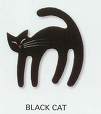 Are
you aware that persecution of witches and their cats is still
happening today, in the twenty-first century? Are
you aware that persecution of witches and their cats is still
happening today, in the twenty-first century?
OK, that statement is a bit
dramatic as no one is getting burned at the stake. Now. But for
over a period of 500 years in medieval Europe, women who were
believed to be witches, and their cat companions, who were thought
to perform evil services on their behalf, were persecuted, tortured
and yes, burned at the stake. Today, the persecution is subtler.
But if you are a woman caring for cats, especially stray cats,
then chances are you have encountered the societal projection
of a centuries-old stigma against women and cats, a stigma that
often takes the form of verbal abuse, mockery, and threats.
So how did this stigma toward
women, witches, and cats begin? In centuries and cultures past,
the cat was considered sacred and treated like royalty. The most
famous feline worship took place in Egypt, where the goddess
Bastet took the form of a cat. As companion to the Sun-god Ra,
Bastet brought good fortune, and represented the beneficent healing
rays of the sacred sun. She was also a representative of the
moon, as she was considered the eye of the Sun-god during the
hours of darkness. Cats were so worshipped in ancient Egypt,
that it was considered a crime punishable by death to harm one,
and when a beloved family cat died, a period of mourning was
enforced by the state.
The beautiful Roman goddess
of the moon and protectress of animals, Diana, chose the cat,
feline huntress of the night, as her sacred symbol. In Norse
mythology, Freya, goddess of love and Mother of Life, flew through
sun-drenched skies in a chariot pulled by two black cats. Freya
was so beloved, that the day most sacred to the Northern Europeans
was named in her honor: Friday.
Gods and goddesses, as well
as all of us mere mortals, carry a darker side to the psyche,
and in ancient myth, this shadow side was personified to represent
the dual nature of the deity. The aggressive nature of the Egyptian
Bastet was portrayed in the lion-headed Sekhmet, the fierce goddess
of war who represented the destructive scorching aspects of the
sun. Freya's alter ego was know as Hel (with one L), and as Freya
represented summer and the lightness of flight, Hel, although
still beautiful, stood for winter. As Mother of Death, Hel reigned
in the underworld where she lovingly received those spirits who
had passed on.
As Christianity became the
predominant belief throughout Europe, one of two things happened
to the goddesses and their cats. They were either absorbed into
the new belief system, with their archetypal energies renamed
to reflect monotheistic values (the Celtic goddess Brighid, who
had a cat companion, is often thought to be the predecessor of
Saint Brigit), or, they were banished altogether and branded
as witches or demons. In Hel's case, Christianity transformed
the compassionate goddess of the underworld to an actual abode
of hideous death and named it, Hell. While the once sacred cats
of Freya and Hel, the Mother of Life and Death, were vilified
as attendant devils and familiar companions of an evil witch.
It is said that the "gods and angels of an earlier religion
are the demons of the creed that supercedes it," and so,
in the Middle Ages, an estimated 100,000 women, and no one knows
how many cats, were burned alive. Many of those so-called witches
were elderly women living a solitary isolated life with a pet
cat as their only company. Even today, the shadowy Medieval fear
of the beloved goddess and her companion cat, the fear that found
its way to the shores of this country in Salem, and is the horrific
part of the deeply embedded, cultural Western European heritage
that informs the psyche of this country, still rears its frightened
hateful head and mocks those generous and compassionate women
who choose to care for animals in need of help.
Isn't it time to banish the
true demons, fear and ignorance, and embrace a culture of compassion
and love? Let's start by thanking those women who devote their
time, energy, and resources to helping the feline ancestors of
Bastet.
Copyright 2006
Voice of the Animal
Visit us at http://www.VoiceOfTheAnimal.org to order
a Volume One- Voice of the Animal CD for yourself or a friend.
Hear
Voice of the Animal every week on Animal Radio®,
or anytime at Animal Radio's Full-time channel.
Animal Radio® made possible by: SCOOP
FREE AUTOMATIC LITTER BOX
 ScoopFree
is a revolutionary breakthrough litter box you can leave alone
for up to thirty days. Imagine not having to touch litter or
handle waste for a whole month! With ScoopFree you just
replace the disposable, throwaway litter tray filled with Fresh
Step® Crystal litter as little as once a month with one cat
and twice a month with two cats. That's it! The crystal litter
locks away odor and provides unbeatable odor control. ScoopFree
automatically rakes and grooms the litter, leaving it smelling
clean and fresh. There is nothing to scoop, nothing to refill
and nothing to clean for weeks at a time. It's that easy. It's
clean. It's hands-off. It's the world's first no-touch litter
box. http://www.ScoopFree.com ScoopFree
is a revolutionary breakthrough litter box you can leave alone
for up to thirty days. Imagine not having to touch litter or
handle waste for a whole month! With ScoopFree you just
replace the disposable, throwaway litter tray filled with Fresh
Step® Crystal litter as little as once a month with one cat
and twice a month with two cats. That's it! The crystal litter
locks away odor and provides unbeatable odor control. ScoopFree
automatically rakes and grooms the litter, leaving it smelling
clean and fresh. There is nothing to scoop, nothing to refill
and nothing to clean for weeks at a time. It's that easy. It's
clean. It's hands-off. It's the world's first no-touch litter
box. http://www.ScoopFree.com
| Veterinary Minute
with Dr. Jim Humphries |
Pet Proofing Your Home
Your home is a haven
and a place of safety for you and for your pet. But, inside every
house are poisons, dangers, and hazards that can injure your
dog or cat. Here are some helpful tips to help keep your pet
safe and out of the emergency room!
The two kittens raced around
the apartment, through the bedroom, under the bed and out into
the living room. After circling the bar twice, Dora could not
help but become entranced with the swaying tinsel hanging from
the lower branches. Soon, her brother, Vulcan, was also busy
swatting at the strands and seeing how much damage he could do
with his teeth. Little by little, the tinsel disappeared into
the bellies of the kittens.
Disasters such as this one
are common to veterinary emergency room personnel, but not usually
well known by pet owners. Not only can our pets damage valuable
items and destroy our clean living areas, but they can hurt or
poison themselves, sometimes fatally. Knowing a few helpful hints
can help keep your home is working order and help keep your four-legged
friends out of the veterinarian's office.
According to consultants at
PetProTech pet safety products, most pet emergencies result from
ingestion of toxins, ingestion of non-digestible materials leading
to intestinal blockages, and accidents causing fractures or soft
tissue trauma. The ASPCA Poison Control Center urges pet owners
to search every room of the home and try to look at it from a
toddler's perspective. If the toddler can reach it, so can the
new puppy or kitten.
Puppies chew to help explore
their world as well as relieve stresses. Remember that puppies
will often view anything on the floor as fair game. It is important
to pick up potential hazards such as batteries, tobacco products,
coins, and many household plants. Although new kittens are not
prone to chew like puppies, houseplants, especially in the lily
family, can be extremely poisonous to cats. To keep your kittens
safe, keep dangerous plants out of reach, or, better yet, outside.
For both types of pets, it is extremely important to put away
all medications, both yours and theirs. A single acetaminophen
caplet can kill an adult cat and many dogs will eagerly over
consume the beef flavored pain relieving drugs created for them,
leading to potential stomach ulcers, bleeding, or kidney damage.
Trash cans and garbage bags
are often irresistible to both dogs and cats. The aroma of foods
and other apparently "delicious" items is often too
much for even a well-trained pet. To the pet, getting into the
garbage is its own reward when tasty leftovers and treats can
be found. Keep food scraps, especially cooked bones, in a secure
container, preferably behind a locked or child-proof door. Simply
placing the trash can up on a counter will not always assure
safety. Besides making a mess, garbage can raiding can lead to
stomach upsets, vomiting, diarrhea, or even obstructions and
perforations of the intestinal tract.
During the holidays, many people
become soft-hearted and give "just one treat" to the
begging pet. Unfortunately, too many treats, or the wrong types,
can cause severe stomach upsets and may lead to an emergency
visit to the veterinarian. Bones, fatty foods, onions, and alcoholic
beverages should not be on your pet's holiday menu. Thanksgiving
can be especially difficult and many emergency rooms report higher
than normal number of pancreatitis cases and intestinal blockages
during this time. Chocolates, especially dark or baking chocolates,
should never be given to pets. Even seemingly harmless treats,
such as grapes or raisins, have caused deadly kidney damage to
dogs. Ask your guests to honor your holiday wish and restrain
from giving holiday food to your pet.
Other holiday dangers can include
ingestion of mistletoe, holly, or the water from the live Christmas
tree. All of these have the potential to make your pet seriously
ill. If your cat is very inquisitive, it may be necessary to
keep the tree behind a closed door. The tree's decorations are
also a potential for causing an emergency visit due to ingestion
or lacerations from broken ornaments.
Read the labels of insecticides
well to insure that your pets will not be harmed by their use.
Place rat, mouse, or ant traps and poisons in locations unlikely
to be found by your pet. Pet safety experts say that granular
pesticides are much safer than pellet pesticides because the
pet is less likely to eat the granules. Anti-freeze is a well-known
poison to pets, but other garage items, such as gasoline, oils,
and fertilizers can be dangerous as well. Keep these items out
of pet's reach and wipe up all spills as they happen.
The number of items in our
homes that can hurt a dog or cat are just as numerous as items
that can harm a child. Being proactive and preventing the pet
from eating the wrong item or getting into a situation that can
harm him or her is the best way to avoid injuries. If you suspect
your pet has ingested something toxic or potentially been injured
by a household object, contact your veterinarian immediately.
For more ideas on how to pet proof your home, visit http://www.MyVNN.com
for ideas and remember that your veterinary staff are also great
resources for ideas on how to keep your dog or cat from getting
into trouble.
Dr. Jim Humphries is President and News Director of Veterinary News Network. Hear the Veterinary Minute on Animal Radio®.
Animal Radio® made possible by: World's
Best Cat Litter

Your cat deserves the world's
best. All natural and safe litter made from whole-kernel corn
provides superior odor control, clump-ability, scoop-ability
and flush-ability. Visit http://www.worldsbestcatlitter.com to find
a retailer near you.
ASK
THE CAT COACH - Marilyn Krieger
Certified Cat Behavior
Consultant
How Do I Make My Outdoor
Cat Inside Only?
 Dear
Cat Coach, Dear
Cat Coach,
My cat, BeeBop, has enjoyed
being an inside/outside cat for most of his life. After hearing
you speak a few weeks ago, I've come to the conclusion that it
would be safer for him if he never went outside. I adore him,
and want him to be disease free and live a long life. I have
tried a couple of times to keep him in the house but he howled
and started to tear the carpets up around the doors. I felt so
bad that I let him out again. What should I do? How do I convince
BeeBop that he should live indoors and not go outside?
Carrie in San Francisco
Dear Carrie,
You are absolutely right! Cats that live the outdoor life routinely
become victims of cars, animals, diseases, thieves, etc. The
average life-expectancy of an outdoor cat is around 3-5 years.
An indoor cat has an average life span of 12-15 years, at least
3 times longer then its outdoor counterpart.
Before convincing any cat that
it should change its life style, it's important to have it spayed
or neutered. Spaying and neutering helps to keep the cat population
down and also helps to eliminate frustration, stress and accompanying
behavior challenges such as spraying, howling and fighting.
The most cantankerous nature-loving
cat can be persuaded to move operations inside 24/7. It may be
easier to transition BeeBop to inside living during the winter
months when it's cold and wet outside. Most domestic cats will
choose a warm spot on a couch over keeping dry under a bush.
Begin the transition to inside living by feeding BeeBop exclusively
indoors. There shouldn't be any food available for him outside.
Put BeeBop on a consistent feeding schedule. Feed him 3-4 times
at the same time, every day. In order for him to associate you
as the food provider, don't leave food around for him to eat
whenever he's hungry. After every meal, keep BeeBop in for longer
periods of time, but make it interesting and fun for him so that
he wants to stay inside.
Part of the life style change
from street cat to house cat will involve convincing BeeBop that
relocating inside is much more interesting and fun then being
outdoors. Be creative, bring the outdoors in. Fascinating, cat-centric
indoor activities include providing a diversity of stuff to climb
on, lots of space to explore, places to hide and interactive
toys to play with. Start by increasing the vertical space. Since
cats love to climb, provide your cat with tall cat trees/gyms
or install accessible carpeted cat shelves around the perimeter
of select rooms in your home. When buying or constructing a tall
tree, make sure that it has a very sturdy base so that over-exuberant
cats can't accidentally knock it over. Cat furniture is available
with carpeted enclosures that BeeBop will love to go in. Hang
objects that he will be fascinated with from the shelves on the
cat trees.
Bribery works too. Find a treat
that BeeBop loves. Make him work for his treats by converting
a whiffle ball into a treat ball by stuffing treats in it. Ping
pong balls work well too. After punching multiple holes in a
ping pong ball, fill it with treats and then give it to BeeBop.
He will spend hours trying to remove the treats from the ball.
Additionally, BeeBop will need
regularly scheduled play sessions. Play with him before his meals.
At the end of the play session let BeeBop "catch" the
toy and then feed him his meal. After BeeBop eats, he will groom
and then take a little nap. Make sure that he has a number of
comfortable napping areas to choose from.
Provide BeeBop with hours of
entertainment by installing a carpeted window perch and than
hanging a bird feeder outside the window with the perch. Make
sure that the windows and window screens are secure and closed.
Some cats are very strong and can easily punch out window screens.
Others can squeeze through windows that are barely opened. Another
source of entertainment is the TV. Turn on the Animal Planet
or run a DVD/tape that has been made especially for cats. These
tapes feature birds, animals, insects and fish and some cats
find them fascinating.
Making your home more interesting
and intriguing then the great outdoors will result in BeeBop
preferring to live the life of a King inside his own private
domain. BeeBop will live a longer and healthier life and will
give you long years of companionship without the howling.
© October 2006 by Marilyn
Krieger.
You can find out more about The Cat Coach at http://thecatcoach.com
Marilyn can be reached for consultation to solve feline behavior
issues either by e-mail marilyn@thecatcoach.com
or by phone: 650 780 9485. Additionally, she is teaching classes
in San Francisco on Cat Behavior Problems at Pet Food Express
http://petfoodexpress.com/community/thecatcoach_calendar.html
Marilyn is certified through The International Association of
Animal Behavior Consultants
Animal Radio® made possible by: XFLEAS.com
 Xfleas.com
is your Internet solution for flea control and heartworm prevention.
We carry Advantage and Frontline flea control, Advantage for
cats, Advantage for dogs, K9 Advantix, Revolution flea control,
Interceptor for dogs, Program flea control, and much more. Here
at www.xfleas.com,
we strive to provide the very best in personalized, efficient
customer service. Our goal is to fill and ship most orders within
two business days of being placed and, as always, there are no
charges for shipping. http://www.XFLEAS.com Xfleas.com
is your Internet solution for flea control and heartworm prevention.
We carry Advantage and Frontline flea control, Advantage for
cats, Advantage for dogs, K9 Advantix, Revolution flea control,
Interceptor for dogs, Program flea control, and much more. Here
at www.xfleas.com,
we strive to provide the very best in personalized, efficient
customer service. Our goal is to fill and ship most orders within
two business days of being placed and, as always, there are no
charges for shipping. http://www.XFLEAS.com
| Animal
Minute with Britt Savage |
Oldest Crow Lives to Age
59
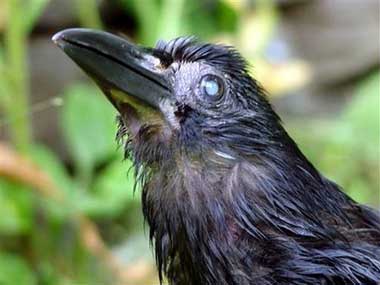 Even
though it can't be proven, experts say it is possible that Tata,
the crow, was 59 when he died. Even
though it can't be proven, experts say it is possible that Tata,
the crow, was 59 when he died.
Tata was never able to fly
after a thunderstorm blew him out of his nest in a Long Island
Cemetery. Tata was taken by the cemetery caretaker to a local
family who was known for taking care of animals in the past.
The family took care of Tata for over 50 years, when they had
to give him up due to their own health problems.
Tata then lived out the remainder
of his life, even though he was blind and had cataracts, with
Kristin Flones.
Hear Britt and the Animal Minute at AnimalRadio.com
Animal Radio® made possible by: Pet Solution Rx
 A revolutionary 100% natural cleansing
and healing, first aid treatment for pets, the main ingredient
is "electrolyzed oxidizing water" and has healing hydrogen
ions added that attract the oxygen ions to help accelerate healing
from wounds. Groomers have found it indispensable for healing
rashes, skin nicks, or when trimming nails. Pet Solution RX from
the makers of Dogonit and G-Whiz. A revolutionary 100% natural cleansing
and healing, first aid treatment for pets, the main ingredient
is "electrolyzed oxidizing water" and has healing hydrogen
ions added that attract the oxygen ions to help accelerate healing
from wounds. Groomers have found it indispensable for healing
rashes, skin nicks, or when trimming nails. Pet Solution RX from
the makers of Dogonit and G-Whiz.
http://www.EarthsBalance.com
Hamster Lives to Tell Tail
after Shredder
 A hamster survived after being
found in a giant shredder, which is used to destroy large items
such as washing machines. A hamster survived after being
found in a giant shredder, which is used to destroy large items
such as washing machines.
It was believed that the hamster
must have gotten into a skip of rubbish that was destined for
the recycling plant. After spending several minutes passing through
the large shredder, the hamster was found virtually unharmed.
The hamster has since been
named Mike and was adopted by Liam Bull, whose father works at
the recycling center.
| ANIMAL
RADIO BOOK REVIEW for October |
|
Entrance into the Animal
Radio® Book Club
    (rated
4 paws) (rated
4 paws)
I Have Heard You Calling
in the Night - Thomas Healy (a memoir)
 Hardcover: 224 pages Hardcover: 224 pages
Publisher: Harcourt (October 2, 2006)
ISBN: 0151012598
We all have our demons, whether
they are tangible or not. We all need someone, whether they have
two legs or four. Thomas Healy's demon was the bottle, and the
someone who saved him was his dog, Martin.
Remembering a dog he had as
a young boy, Thomas yearned for another dog when he came across
an ad for Dobermans, and selected a puppy. Martin, as he would
soon be named, became Thomas' best friend.
Martin would nurse Thomas through
illness and wounds, and would stand guard over him when he was
passed out. Their bond enabled Thomas to begin to recover from
his alcoholism and understand himself and God.
Martin, in more ways than one,
saved Thomas Healy's life.
See other reviews at AnimalRadio.com.
Send books and literature for review on-air and in this newsletter
to: Animal Radio Network™ Book Reviews, 233 East 330 North,
Kanab, Utah 84741. Product may not be returned. Allow 5 weeks
for review.
|
|
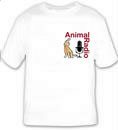 NETWORK PROGRAMS: NETWORK PROGRAMS:
Animal Radio®
Animal
Wise Radio
Pet Talk
Radio!
Talk with
Your Animals
Veterinary
Minute and Animal Minute
Voice
of the Animal
Dog Talk The Radio Show
|
Currently
On-Air
Animal
Radio Network® Full-time channel
|
LISTEN TO ANIMAL RADIO NETWORK NOW
PLATFORMS
AND PLAYERS
LISTEN AT WORK...all day long. Fresh animal programming
24/7. Be sure to view our programming schedule to catch your
favorite show.
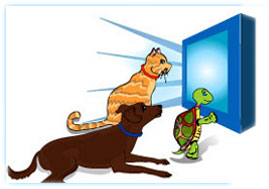 PET STORES, VETS, GROOMERS: Would you like to broadcast Animal
Radio Network® in your store or office? It's E-Z!
Call 435.644.5992 to get set up. Animal Radio Network®
is simulcast on the PetVision Network throughout America to your
store. PET STORES, VETS, GROOMERS: Would you like to broadcast Animal
Radio Network® in your store or office? It's E-Z!
Call 435.644.5992 to get set up. Animal Radio Network®
is simulcast on the PetVision Network throughout America to your
store.
 Listen
to Animal Radio Network's full-time Animal Channel ANYTIME on
ANY CELL PHONE, ANY PROVIDER. The Mobile Broadcast Network
now features Animal Radio Network™ 24/7. Find out how to
listen FREE (normal airtime rates apply) by visiting MYMBN.com. Animal
Radio Network® is program number 1221. Listen
to Animal Radio Network's full-time Animal Channel ANYTIME on
ANY CELL PHONE, ANY PROVIDER. The Mobile Broadcast Network
now features Animal Radio Network™ 24/7. Find out how to
listen FREE (normal airtime rates apply) by visiting MYMBN.com. Animal
Radio Network® is program number 1221.
Animal Radio® is made possible
by: CANINE CAVIAR 
Canine & Feline Caviar provides
all-natural holistic pet foods & treats that use human grade
or edible meats and grain. Canine Caviar uses hormone, antibiotic
and pesticide free USDA chicken & New Zealand lamb and Venison
that are raised in a free-range environment. Our Chicken and
Lamb dry diets use pearl millet as an alternative and the Venison
& Organic Split Pea diet is GRAIN FREE. We also have a frozen
raw food diets (grain free), canned foods (grain free) and treats,
which are all great skin and coat conditioners.
http://www.CanineCaviar.com
{Editors Note: We are absolutely
thrilled to have Australia's top animal show on Animal Radio
Network™ We've brought together the world's best pet programs
under one roof. If you haven't heard our full-time animal channel
- check
it out now }
G'day from Downunder... Sydney
NSW to be precise.
Did you know October 4 is World
Animal Day? - there's a number of great websites with more information
for you, but we found this: www.worldanimalday.org.uk
Basically - the whole idea
is to celebrate animal life in all its forms and our relationship
with animals.
It's also to acknowledge the
diverse roles that animals play in our lives - from providing
food, through being our companions, to supporting and helping
us, to bringing a sense of wonder into our lives and to acknowledge
and be thankful for the way in which animals enrich our lives.
We have to admit those worthy
phrases come straight off the World Animal Day website, but what
do they really mean to the average pet owner?
In Australia right now there
is great debate over whether immigration visas should only be
given to those people who can speak our language and have an
understanding of our culture. On the back of that we thought
we'd start a test of our own for pet owners... We're going to
call it 'The Great Aussie Pet Test'!
The idea is that on October
4 this year - and we hope every year - all pet owners do a test
that not only helps them understand more about animals, but also
helps them learn about stuff they maybe didn't know... 'Like
how do Turtles breathe?' or 'Is it better to let dogs & cats
have a litter before spaying or neutering?(answers below)
The idea of the Great Aussie
Pet Test is that everyone's a winner! Why?, because no matter
if you answer correctly or incorrectly, pet owners get to learn
a lot more about their own animals, and about some of the other
animals in our environment.
So while the official 'World
Animal Day' is a great global concept, we think acting locally
- starting with Pet Talk Radio! listeners, is another proactive
way of helping people celebrate animals.
Ok, something completely different
- and it looks like the temperatures are cooling in your part
of the world right now heading into fall but here in Australia
it's the opposite! - But it's never too late to have a pet disaster
plan, and after recent years and the horrendous fires we've had,
we're starting to get people to plan for that emergency that
may just strike when we least expect.
Fires, floods, hurricanes and
even terrorism are now all part of everyday life all over the
world - most authorities find animals to be a real problem in
emergencies for many legitimate reasons, so it's never too late
to plan what you are going to do if (when?) disaster strikes.
There are plenty of good websites
out there and no doubt some great books - best of all, check
with your local city hall, fire department or emergency services
for what they suggest you do in your particular area... Or give
the local SPCA a call.
Finally (and we promise we'll
bring back the fun next month!) - have you included you pets
in your will?... If you have an accident, who will look after
them?
We bring you this reminder
in honour of 'WildLife Warrior' Steve Irwin who made darn sure
his legacy of caring conservation for all animals will be carried
on for many generations to come....
Something to think about eh?
Until next month, take care
and hugs for your pets from Brian & Kaye
ANSWERS TO QUESTIONS ABOVE:
Turtles breathe through their 'Cloaca' (basically their bum!)
And ALL domestic animals should be spayed or neutered BEFORE
their first 'heat'. This helps prevent accidental liters and
many problems later in life such as ovarian cancer in females
etc. Ask your veterinarian for more information or listen to
Animal Radio Network or Pet Talk Radio - (preferably both!!)
Hear
Pet Talk Radio! on Animal Radio Network® - Check schedule for showtimes.
Animal Radio® is made possible by:
GET SERiOUS!

- Extracts stains & odors COMPLETELY
-in only 3 minutes! - Extracts the urine &
the pheromone -so pets aren't attracted back to re-mark!
- Never leaves any "yellowing" behind (like
most enzyme-based cleaners) and even removes old locked-on
"yellowing" - left behind by other cleaners!
-1 bottle of GET SERiOUS! cleans as much
as 2 bottles of the competition because you only use 1/2 as much
as the others! - $AViNGS ! $AViNGS
! $AViNGS !
http://www.GetSeriousProducts.com
Animal
Radio® is available for iTunes.
 If
you don't have the free iTunes software for MAC
or Windows - download it free. Then open iTunes and select "Podcasts,"
type "Animal Radio" into the search podcasts
box. You may subscribe to a new episode every week...FREE! If
you don't have the free iTunes software for MAC
or Windows - download it free. Then open iTunes and select "Podcasts,"
type "Animal Radio" into the search podcasts
box. You may subscribe to a new episode every week...FREE!
 Animal Radio®
is also available on Yahoo! too!! Animal Radio®
is also available on Yahoo! too!!
ASK "THE DOG BIBLE" - Based on THE DOG BIBLE: Everything
Your Dog Wants You To Know by Tracie Hotchner
Dogs and Cats in Harmony
 Nearly
half the homes in America that have pets include dogs and cats,
so despite expressions like "Raining cats and dogs,"
we know that these two species can actually coexist quite well.
A dog and cat share the same home and the same humans. One of
the things they definitely share is that we basically provide
for their every need, since people have transformed these two
species by domesticating them into a dependent co-habitation
with humans that is almost a parent-child relationship. Despite
enormous differences in the natural behavior of dogs and cats,
and in their wild ancestors, the two species can live together
harmoniously and even form bonds as strong as those they each
have with their human caretakers. Nearly
half the homes in America that have pets include dogs and cats,
so despite expressions like "Raining cats and dogs,"
we know that these two species can actually coexist quite well.
A dog and cat share the same home and the same humans. One of
the things they definitely share is that we basically provide
for their every need, since people have transformed these two
species by domesticating them into a dependent co-habitation
with humans that is almost a parent-child relationship. Despite
enormous differences in the natural behavior of dogs and cats,
and in their wild ancestors, the two species can live together
harmoniously and even form bonds as strong as those they each
have with their human caretakers.
Differences in how dogs
and cats relate: Cats
and dogs are not natural enemies, but they aren't natural friends,
either. Dogs and cats rarely compete for the same thing because
they usually don't want what is important to the other, which
is a large part of what makes peaceful cohabitation possible.
When living under the same roof, they both need food and water,
territory and the affection of the people but as long as they
are separate but equal, the potential for "sibling rivalry"
and the resentment that comes with it, can be avoided. If these
two animals from different species live together over several
years, they come to an understanding of each other and learn
to respect the different issues that are important to each of
them.
A cat takes much longer
to warm up: If your
cat has not had a dog in the house before, expect the cat to
have a meltdown when the dog arrives, and don't be surprised
if it lasts a fairly long time. Most cats take months to adjust
to having a dog in the house-and there's not really anything
you can do to speed the process along. As long as the cat has
high places to jump up onto, away from the dog, there's no danger
of serious harm coming to her. Normal defensive behaviors for
a cat are hissing, swatting and arching her back, so don't worry
if your cat does that with a dog either in the beginning or really
at any time that she is trying to get her point across.
Dogs and Cats: Living Together
Successfully
On some level your cat will
probably never fully forgive you for polluting her world with
a canine. There are some cats who actually like dogs, but more
frequently the best they can do is come to accept a dog they
live with but usually just one. A cat can go past tolerance
to actual friendship with a dog, but that is unusual. Anyone
who has had a mixed dog/cat household can tell you that cats
are discerning about their interspecies friendships and may come
to really be close to one dog while rejecting all others.
Start Young: The most successful relationships
between dogs and cats are those that begin when both animals
are young, introduced as puppies and kittens, which allows them
grow up together and figure each other out. If you do not have
two youngsters from both species, then it is better to have a
kitten, who can adapt more easily to a grown dog than a puppy
would be able to win over a grown cat.
Territoriality: Dogs can be territorial about specific
locations and objects, especially dominant males of terrier breeds
and working breeds. Some dogs can get vicious about things like
food and water bowls, special areas of a room, their beds and
people of whom they're especially fond.
Things that matter most
to a cat: Cats can
also prize locations and objects, but they'll rarely fight over
them and even then only with another cat, not a dog. What does
make a cat fiercely assertive are: pathways leading to
those favorite locations, attention from favorite people, play
objects (especially catnip) and special food treats.
Differences in the social
order of the two species:
While dog and cat behavior is quite different, both species do
have a pecking order but the difference is that with cats,
the ranking of who is on top is constantly fluctuating. Cats
do not have a social order that is easily understood. In the
wild, most cats are solitary creatures who come together and
stay together to mate and raise their young. Otherwise the males
and females live separately within their own territories (the
only cat this is not true of is a lion, who lives in a pride,
which is a kind of pack). The lifestyle of cats in the wild gives
clues about the independence of domestic cats, who give the impression
they are indifferent to human attention. But domestic cats have
been pampered by humans who cater to their every need cats have
learned to crave the affection, grooming, scheduled fancy meals
and affection lavished on them by their people. You could say
this is something they have developed in common with dogs: a
shared dependence on humans. So while we enjoy having both these
animals share our lives, it is up to us to bring them together
in a way that enhances the quality of their lives, too.
 {"Ask
THE DOG BIBLE..." is a regular column by Tracie Hotchner
- Featuring excerpts from her new 700 page encyclopedic book
that has been called "a Dr. Spock for dogs." Further
information may also be on her website, http://www.thedogbible.com, where you can
email questions.} Copyright 2006 by Tracie Hotchner, All
Rights Reserved {"Ask
THE DOG BIBLE..." is a regular column by Tracie Hotchner
- Featuring excerpts from her new 700 page encyclopedic book
that has been called "a Dr. Spock for dogs." Further
information may also be on her website, http://www.thedogbible.com, where you can
email questions.} Copyright 2006 by Tracie Hotchner, All
Rights Reserved
Hear Tracie Hotchner as she hosts
Dog Talk The Radio Show on Animal Radio Network® Consult schedule for showtimes.
Animal Radio® made possible by:
PET SOUP
 Pet
Soup has expanded its extensive line of premium-quality designer
pet products by adding another type of high performance mat-
the Deluxe Series. All of the same imaginative designs available
on the original mats, now called the Elite Series, can be ordered
on the new line as well. Pet Soup makes durable, premium quality
mats and accessories for the pampered pet, in a variety of sizes
for home and travel. All mats feature a non-slip, hypoallergenic
backing that grips and protects floors. The finely detailed images
won't fade, crack, peel, or wash off. Call 888-842-6804 for a
free catalog, or view their extensive collection of designer
products online at www.pet-soup.com and check out their matching
designer litter trays. Pet
Soup has expanded its extensive line of premium-quality designer
pet products by adding another type of high performance mat-
the Deluxe Series. All of the same imaginative designs available
on the original mats, now called the Elite Series, can be ordered
on the new line as well. Pet Soup makes durable, premium quality
mats and accessories for the pampered pet, in a variety of sizes
for home and travel. All mats feature a non-slip, hypoallergenic
backing that grips and protects floors. The finely detailed images
won't fade, crack, peel, or wash off. Call 888-842-6804 for a
free catalog, or view their extensive collection of designer
products online at www.pet-soup.com and check out their matching
designer litter trays.
http://www.Pet-Soup.com
Maggie, Animal Ark's Most
Recent Puppy Mill Rescue, Sheds Light on Plight of Animals in
Mills
 Her corneas are discolored from an
eye infection. When rescued, she gasped for breath due to a respiratory
infection. Her feet are red and swollen from walking on the sharp
wire floor of her cage. Her legs have not fully formed, probably
from an inability to use them during her primary growing months.
She is Animal Ark's latest puppy mill rescue. Her name is Maggie,
and she has stolen the hearts of the staff and volunteers caring
for her. Though she has clearly received no training or socialization
in her short life, she seems to understand the new people in
her life are here to help her, and that her life has taken a
sudden turn for the better. She has, at least, stopped biting,
for the most part. Her corneas are discolored from an
eye infection. When rescued, she gasped for breath due to a respiratory
infection. Her feet are red and swollen from walking on the sharp
wire floor of her cage. Her legs have not fully formed, probably
from an inability to use them during her primary growing months.
She is Animal Ark's latest puppy mill rescue. Her name is Maggie,
and she has stolen the hearts of the staff and volunteers caring
for her. Though she has clearly received no training or socialization
in her short life, she seems to understand the new people in
her life are here to help her, and that her life has taken a
sudden turn for the better. She has, at least, stopped biting,
for the most part.
A kind person rescued Maggie
from a large puppy mill near Little Falls. Her condition is unfortunately
common for animals rescued from large, pet factories. Animal
Ark needs your support to help Maggie, and other animals like
her. She needs to see an eye specialist. She needs radiographs
to evaluate the condition of her legs. She can currently walk,
but is clumsy and awkward when she does. She can't run. Surprisingly,
she is only about 10 months old. And, already, she is suffering
chronic neglect due to the lack of care she received in her previous
"home".
"There are tens of thousands
of dogs living in Minnesota like this," said Mike Fry, executive
director of Animal Ark. "The largest puppy mills in our
state have thousands of breeding adult dogs and uncounted numbers
of puppies."
The subject of puppy mills
began making local press in January of this year when Morrison
County issued a Conditional Use Permit to Garry McDuffee to operate
a 600-dog breeding facility (not counting puppies). Since then,
Minnesota puppy mills have made the press in Detroit, New York
and other states, because puppies raised here are shipped around
the country. They are sold in pet shops and via the Internet.
Minnesota has, unfortunately, begun to earn a national reputation
for being one of the centers of the puppy mill trade.
In spite of the press, puppy
mills continue to do booming business in Minnesota.
"The USDA has proven woefully
inadequate at regulating this industry," said Fry. "And
the humane investigators in our state have not done much better."
To prove his case, Fry cites
another case that has recently received a fair amount of press.
Ruben Wee used to operate a
puppy mill in southwestern Minnesota. Conditions at his facility
were so bad that dead animals were found on the property during
at least one inspection by the Companion Animal Protection Society
(CAPS). To avoid inspections by USDA, all Wee needed to do was
tell them he was no longer selling animals commercially. Rather
than fining him, they then just stopped inspecting. CAPS investigators
took their investigation to local humane investigators. But it
was years before any of them even visited the facility. Eventually,
with pressure from Animal Ark, local law enforcement charge and
convicted Wee of animal cruelty.
"It is not that the humane
investigators in Minnesota are bad," said Fry. "However,
it is clear that they do not have the skills or resources needed
to address a problem as large as this."
By large, Fry means overwhelming.
There are hundreds of USDA licensed commercial breeders and dealers
in Minnesota. Add in the ones operating illegally and consider
that some facilities have thousands of breeding adults, and it
is easy to see why humane investigators are overwhelmed.
"Closing one of the largest
puppy mills in the state would require an effort roughly comparable
to the work of the Hurricane Katrina Rescue efforts operated
out of Tylertown, Mississippi, That required a large, national
response, hundreds of volunteers and months of work." Fry
said. "We are talking about thousands of unsocialized animals
with medical and behavior problems."
Solving this problem is going
to require new legislation, and a large, coordinated effort with
the area's largest animal welfare organizations stepping in to
help. Cooperation with large, national animal welfare groups
will also be necessary. He also believes that a bipartisan congressional
investigation into this issue is warranted.
As for Animal Ark's latest
puppy mill rescue, Fry expects she may never be a "normal"
Pekinese. However, he believes she will recover enough to have
a good life following her rescue.
Links:
Sponsor Maggie
Donate to Help Put A Stop to Puppy Mills
Companion
Animal Protection Society
Puppy
Mill Community at Best Friends Network
Animal Ark's Puppy Mill Resource Center
If you prefer to donate by
mail:
Please send a check to:
Animal Ark
809 E. 7th Street
St. Paul, MN 55106
Please indicate your donations is to help put a stop to puppy
mills.
Mike Fry, Executive
Director, Animal Ark No-Kill Shelter
Hear Animal Wise Radio on Animal Radio Network™
Animal Radio® made possible by:
PRECIOUS CAT ULTRA LITTER
ATTRACTANT
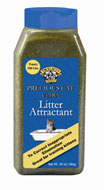 Dr. Elsey's Precious Cat Ultra Litter
Attractant contains a scent that naturally attracts kittens and
cats to use the litter box. It was created through years of observing
and testing cats in shelters and Dr. Elsey's clinic. Industry
statistics show that non-use of the litter box is the number
one behavioral reason cats are abandoned, abused, and placed
in animal shelters. Designed for cats who are not using their
litter boxes, Precious Cat Ultra Litter Attractant is the first
litter attractant to specifically address this problem and provide
a clinically tested and consumer proven solution. Dr. Elsey's Precious Cat Ultra Litter
Attractant contains a scent that naturally attracts kittens and
cats to use the litter box. It was created through years of observing
and testing cats in shelters and Dr. Elsey's clinic. Industry
statistics show that non-use of the litter box is the number
one behavioral reason cats are abandoned, abused, and placed
in animal shelters. Designed for cats who are not using their
litter boxes, Precious Cat Ultra Litter Attractant is the first
litter attractant to specifically address this problem and provide
a clinically tested and consumer proven solution.
http://www.PreciousCat.com
A Common Question
"Why does my cat/dog do ?" is a very common question
I receive. I will ask the caller for more details so I can understand
the situation from the human's perspective. Then I will talk
with the animal kid to find out what their perspective is. Their
perspectives are usually very different from each other.
One of my favorite stories I love to tell about intention and
attention is the one about the cats and the space heater. A woman
called me, very intense and incredibly upset about her cats and
having done EVERYTHING she knew to keep her cats away from her
space heater! The woman lived in an apartment. In the winter
for more warmth she would place a space heater in the middle
of her living room. Every time she went into the living room,
she would feel the heat of the space heater. She was enjoying
the extra heat. All this sounds wonderful and is. What had her
so incredibly upset was the fact that whenever her two cats went
into the living room, the only thing they paid attention to was
the space heater. They were sniffing the heater and lying very
close to it. She was more than upset thinking they would get
burned. So, she did EVERYTHING - yelled, tried to reason, told
them NO!!!, tried to block them from the living room. She had
consulted everyone she could think of - and as a last resort
called me (this often happens - being the last resort for people).
I talked with the cats about the situation. Their perspective
was very understandable and, in fact, very comical. They told
me they thought the warmth was very nice and they did like it.
But they kept going back to it because it was the only thing
in the whole room the person they loved most in the world paid
attention to. They kept going back to the heater because their
person paid attention to only it in the living room.
I explained this whole situation to their mom and gave her some
suggestions. I explained to her that she needed to ignore the
heater and put it everywhere she would want the cats to be in
the living room. I suggested she pay attention to the carpet
with as much vehemence as she did the heater - rub on it, say
how great the carpet was, be very excited about the carpet -
and everything else she thought was a fine place for her cats
to be.
She, of course, thought I was crazy but she decided she had nothing
to loose except some dignity so she did exactly the things I
suggested. She called me back after a few weeks to tell me that
the problem had been solved - her cats no longer paid any attention
to the space heater.
Animals understand everything you say and even more than that,
they know everything you think, even sometimes before you know
what you are thinking. They will even read your mind. They also
especially love to pay attention to the things you are paying
attention to. For those of you with cats, do you notice your
cat will want to be on your lap or the computer when you are
working on it? Or, for dogs, that when you are very intent on
something, that's exactly where your dog wants to be? All animals
will do the same. In fact, it is one of the techniques used to
train horses - pay attention to the thing you want them to become
accustomed to. Eventually they will go to the thing to check
it out.
Here is a great experiment to try. Think of and picture in your
mind something for your animal kid to do and see if he/she goes
and does it. It is a great game and one that would tune you into
each other even more. You can think of lying down, or a certain
toy, or going outside, or food. To start, make it simple because
you will need to pay very close attention to the picture and
your attention until you get very good at doing this. Then you
can play with more complex things.
Without doing this experiment on purpose, one of my clients learned
she has to watch what she is thinking. She just received an e-mail
from a friend regarding cats peeing in the house. She was agreeing
in her head how awful it is for cats to pee in the house. Thank
goodness, this was not an issue in her house any more. The woman
got up from the computer and went into the dining room to find
her kitty peeing on the floor. This kitty had picked out of her
head the picture, kitty peeing on the floor in the dining room
because there is no picture for the word, not. I reminded the
client about intention and attention.
Without realizing it, we are an open book for our animals. We
will let them more into our hearts than another human being.
We have no filters between them and us when it comes to interacting
with them. They are able to pickup on our feelings and words
as well as pictures in our heads. They are great teachers. We
can learn how to be better people by looking at how our feelings,
thoughts and actions effect others whether they be human, animal
or innate objects. Listen carefully to yourself thinking. Is
it positive or negative? Look at the message you are sending
energetically. Is it positive or negative? Listen to the words
you are using. Are they positive or negative? As you pay more
attention to your intention, you will be able to create a better
world for yourself and in turn for your animal kids and everyone
else. So please remember animals do follow your intention as
well as attention.
Until next time, I'm Joy reminding you, you can never love your
animal companions too much. You can only love them, hopefully,
enough.
Talk With Your Animals airs
every weekday on Animal Radio Network's Full-time animal channel.
If you would like to talk with your pet via Joy Turner, please
call 1-866-405-8405 to make arrangements. http://www.TalkWithYourAnimals.com
Animal Radio® made possible by: PET
BOTANICA
.jpg) Pet owners love to pamper their pets.
That is why Pet Botanica offers a full line of the finest natural,
botanical and organic pet grooming and spa products specifically
formulated to pamper pets naturally. The Pet Botanica product
line includes: Pet Conditioning Shampoos, Pet Laundry Wash, Aromatherapy
Dog Mists, Stain and Odor Control products. Pet Botanica products
are highly concentrated (32 to1), groomer quality products made
from plant-based ingredients such as aloe, jojoba, oatmeal, chamomile,
coconut, soy, yucca and tea tree oil. Pet owners love to pamper their pets.
That is why Pet Botanica offers a full line of the finest natural,
botanical and organic pet grooming and spa products specifically
formulated to pamper pets naturally. The Pet Botanica product
line includes: Pet Conditioning Shampoos, Pet Laundry Wash, Aromatherapy
Dog Mists, Stain and Odor Control products. Pet Botanica products
are highly concentrated (32 to1), groomer quality products made
from plant-based ingredients such as aloe, jojoba, oatmeal, chamomile,
coconut, soy, yucca and tea tree oil.
http://www.PetBotanica.com
| PRODUCT
REVIEW for October |
|
    (rated 4 paws) (rated 4 paws)
Nintendogs
Nintendo DS
 At
40 years old, I was taken aback when I was asked to review Nintendogs,
the virtual dog software for the Nintendo DS system. I was pleasantly
surprised with the sound and quality of the Nintendo DS system.
The software allows you to care for, and interact with, a virtual
dog of choice. On one hand, I thought this is a great way to
educate children on how to care for their pet. If you don't socialize
the dog shaped electrons, their disposition changes. On the other
hand, I was disappointed that it encouraged purchasing a breed
specific dog instead of going to a dog rescue. Why not teach
the kids that 5 million animals are being put to sleep every
year no thanks to the breeders and puppy mills. At
40 years old, I was taken aback when I was asked to review Nintendogs,
the virtual dog software for the Nintendo DS system. I was pleasantly
surprised with the sound and quality of the Nintendo DS system.
The software allows you to care for, and interact with, a virtual
dog of choice. On one hand, I thought this is a great way to
educate children on how to care for their pet. If you don't socialize
the dog shaped electrons, their disposition changes. On the other
hand, I was disappointed that it encouraged purchasing a breed
specific dog instead of going to a dog rescue. Why not teach
the kids that 5 million animals are being put to sleep every
year no thanks to the breeders and puppy mills.
Ultimately, I was delighted
with the product for my use, and would get it for my son. The
DS unit can be purchased around $130 and play a multitude of
games in addition to the Nintendogs software which can be found
for about $30 through Amazon.com. This makes for a great stocking
stuffer for the animal lover or the animal lover to-be.
http://Nintendogs.com
Send products for review on-air
and in this newsletter to: Animal Radio Network™ Product
Reviews, 233 East 330 North, Kanab, Utah 84741. Products may
not be returned.
|
 Have you heard US
Lately? Have you heard US
Lately?
So many ways to listen!
Like
KOST 103.5 and KBIG 104.3 in Los Angeles
Website: http://AnimalRadio.com
Toll-Free Studio Line is: 1.866.405.8405
| Search Animal Radio Network® |
|
|
|


 Are
you dressing your pet up for Halloween? We want to see your pix!
Send 'em to yourvoice@AnimalRadio.com
and look for pictures in next month's newsletter.
Are
you dressing your pet up for Halloween? We want to see your pix!
Send 'em to yourvoice@AnimalRadio.com
and look for pictures in next month's newsletter.
 HGTV's CLIVE PEARSE is really a big animal
lover and is helping the dogs of Romania. Why won't the world's
most famous billionaire musician pay to care for his animals?
Animal
Radio® friend and actress TIPPI HEDREN
takes in Michael Jackson's abandoned felines.
What's new for our furry-friends? We're LIVE from SuperZoo Las
Vegas and our NEW PET PRODUCTS Special ...all this week on Animal Radio®
HGTV's CLIVE PEARSE is really a big animal
lover and is helping the dogs of Romania. Why won't the world's
most famous billionaire musician pay to care for his animals?
Animal
Radio® friend and actress TIPPI HEDREN
takes in Michael Jackson's abandoned felines.
What's new for our furry-friends? We're LIVE from SuperZoo Las
Vegas and our NEW PET PRODUCTS Special ...all this week on Animal Radio®
 RECENT
Animal
Radio® PODCASTS:
RECENT
Animal
Radio® PODCASTS: The
SUMMER-END NEW PET PRODUCTS SPECIAL LIVE FROM WWPIA SUPERZOO,
LAS VEGAS was a sucess. Here are the items that made the
cut. Listen to the show and learn more at
The
SUMMER-END NEW PET PRODUCTS SPECIAL LIVE FROM WWPIA SUPERZOO,
LAS VEGAS was a sucess. Here are the items that made the
cut. Listen to the show and learn more at 





 Skamper
Ramp - The Great Water Escape Ramp
Skamper
Ramp - The Great Water Escape Ramp 




 Are
you aware that persecution of witches and their cats is still
happening today, in the twenty-first century?
Are
you aware that persecution of witches and their cats is still
happening today, in the twenty-first century?

 Dear
Cat Coach,
Dear
Cat Coach,
 Even
though it can't be proven, experts say it is possible that Tata,
the crow, was 59 when he died.
Even
though it can't be proven, experts say it is possible that Tata,
the crow, was 59 when he died. A revolutionary 100% natural cleansing
and healing, first aid treatment for pets, the main ingredient
is "electrolyzed oxidizing water" and has healing hydrogen
ions added that attract the oxygen ions to help accelerate healing
from wounds. Groomers have found it indispensable for healing
rashes, skin nicks, or when trimming nails. Pet Solution RX from
the makers of Dogonit and G-Whiz.
A revolutionary 100% natural cleansing
and healing, first aid treatment for pets, the main ingredient
is "electrolyzed oxidizing water" and has healing hydrogen
ions added that attract the oxygen ions to help accelerate healing
from wounds. Groomers have found it indispensable for healing
rashes, skin nicks, or when trimming nails. Pet Solution RX from
the makers of Dogonit and G-Whiz.  A hamster survived after being
found in a giant shredder, which is used to destroy large items
such as washing machines.
A hamster survived after being
found in a giant shredder, which is used to destroy large items
such as washing machines. Hardcover: 224 pages
Hardcover: 224 pages PET STORES, VETS, GROOMERS: Would you like to broadcast Animal
Radio Network® in your store or office? It's E-Z!
Call 435.644.5992 to get set up. Animal Radio Network®
is simulcast on the PetVision Network throughout America to your
store.
PET STORES, VETS, GROOMERS: Would you like to broadcast Animal
Radio Network® in your store or office? It's E-Z!
Call 435.644.5992 to get set up. Animal Radio Network®
is simulcast on the PetVision Network throughout America to your
store. Listen
to Animal Radio Network's full-time Animal Channel ANYTIME on
ANY CELL PHONE, ANY PROVIDER. The Mobile Broadcast Network
now features Animal Radio Network™ 24/7. Find out how to
listen FREE (normal airtime rates apply) by visiting
Listen
to Animal Radio Network's full-time Animal Channel ANYTIME on
ANY CELL PHONE, ANY PROVIDER. The Mobile Broadcast Network
now features Animal Radio Network™ 24/7. Find out how to
listen FREE (normal airtime rates apply) by visiting 


 Nearly
half the homes in America that have pets include dogs and cats,
so despite expressions like "Raining cats and dogs,"
we know that these two species can actually coexist quite well.
A dog and cat share the same home and the same humans. One of
the things they definitely share is that we basically provide
for their every need, since people have transformed these two
species by domesticating them into a dependent co-habitation
with humans that is almost a parent-child relationship. Despite
enormous differences in the natural behavior of dogs and cats,
and in their wild ancestors, the two species can live together
harmoniously and even form bonds as strong as those they each
have with their human caretakers.
Nearly
half the homes in America that have pets include dogs and cats,
so despite expressions like "Raining cats and dogs,"
we know that these two species can actually coexist quite well.
A dog and cat share the same home and the same humans. One of
the things they definitely share is that we basically provide
for their every need, since people have transformed these two
species by domesticating them into a dependent co-habitation
with humans that is almost a parent-child relationship. Despite
enormous differences in the natural behavior of dogs and cats,
and in their wild ancestors, the two species can live together
harmoniously and even form bonds as strong as those they each
have with their human caretakers. Her corneas are discolored from an
eye infection. When rescued, she gasped for breath due to a respiratory
infection. Her feet are red and swollen from walking on the sharp
wire floor of her cage. Her legs have not fully formed, probably
from an inability to use them during her primary growing months.
She is Animal Ark's latest puppy mill rescue. Her name is Maggie,
and she has stolen the hearts of the staff and volunteers caring
for her. Though she has clearly received no training or socialization
in her short life, she seems to understand the new people in
her life are here to help her, and that her life has taken a
sudden turn for the better. She has, at least, stopped biting,
for the most part.
Her corneas are discolored from an
eye infection. When rescued, she gasped for breath due to a respiratory
infection. Her feet are red and swollen from walking on the sharp
wire floor of her cage. Her legs have not fully formed, probably
from an inability to use them during her primary growing months.
She is Animal Ark's latest puppy mill rescue. Her name is Maggie,
and she has stolen the hearts of the staff and volunteers caring
for her. Though she has clearly received no training or socialization
in her short life, she seems to understand the new people in
her life are here to help her, and that her life has taken a
sudden turn for the better. She has, at least, stopped biting,
for the most part. Dr. Elsey's Precious Cat Ultra Litter
Attractant contains a scent that naturally attracts kittens and
cats to use the litter box. It was created through years of observing
and testing cats in shelters and Dr. Elsey's clinic. Industry
statistics show that non-use of the litter box is the number
one behavioral reason cats are abandoned, abused, and placed
in animal shelters. Designed for cats who are not using their
litter boxes, Precious Cat Ultra Litter Attractant is the first
litter attractant to specifically address this problem and provide
a clinically tested and consumer proven solution.
Dr. Elsey's Precious Cat Ultra Litter
Attractant contains a scent that naturally attracts kittens and
cats to use the litter box. It was created through years of observing
and testing cats in shelters and Dr. Elsey's clinic. Industry
statistics show that non-use of the litter box is the number
one behavioral reason cats are abandoned, abused, and placed
in animal shelters. Designed for cats who are not using their
litter boxes, Precious Cat Ultra Litter Attractant is the first
litter attractant to specifically address this problem and provide
a clinically tested and consumer proven solution..jpg) Pet owners love to pamper their pets.
That is why Pet Botanica offers a full line of the finest natural,
botanical and organic pet grooming and spa products specifically
formulated to pamper pets naturally. The Pet Botanica product
line includes: Pet Conditioning Shampoos, Pet Laundry Wash, Aromatherapy
Dog Mists, Stain and Odor Control products. Pet Botanica products
are highly concentrated (32 to1), groomer quality products made
from plant-based ingredients such as aloe, jojoba, oatmeal, chamomile,
coconut, soy, yucca and tea tree oil.
Pet owners love to pamper their pets.
That is why Pet Botanica offers a full line of the finest natural,
botanical and organic pet grooming and spa products specifically
formulated to pamper pets naturally. The Pet Botanica product
line includes: Pet Conditioning Shampoos, Pet Laundry Wash, Aromatherapy
Dog Mists, Stain and Odor Control products. Pet Botanica products
are highly concentrated (32 to1), groomer quality products made
from plant-based ingredients such as aloe, jojoba, oatmeal, chamomile,
coconut, soy, yucca and tea tree oil. At
40 years old, I was taken aback when I was asked to review Nintendogs,
the virtual dog software for the Nintendo DS system. I was pleasantly
surprised with the sound and quality of the Nintendo DS system.
The software allows you to care for, and interact with, a virtual
dog of choice. On one hand, I thought this is a great way to
educate children on how to care for their pet. If you don't socialize
the dog shaped electrons, their disposition changes. On the other
hand, I was disappointed that it encouraged purchasing a breed
specific dog instead of going to a dog rescue. Why not teach
the kids that 5 million animals are being put to sleep every
year no thanks to the breeders and puppy mills.
At
40 years old, I was taken aback when I was asked to review Nintendogs,
the virtual dog software for the Nintendo DS system. I was pleasantly
surprised with the sound and quality of the Nintendo DS system.
The software allows you to care for, and interact with, a virtual
dog of choice. On one hand, I thought this is a great way to
educate children on how to care for their pet. If you don't socialize
the dog shaped electrons, their disposition changes. On the other
hand, I was disappointed that it encouraged purchasing a breed
specific dog instead of going to a dog rescue. Why not teach
the kids that 5 million animals are being put to sleep every
year no thanks to the breeders and puppy mills.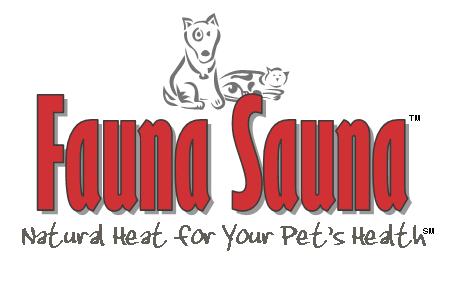 Fauna Sauna™ is the first far infrared
(FIR) radiant heat therapy device designed specifically for pets.
It can be used to improve the health of a sick animal as well
as for general warmth and comfort. With Fauna Sauna™, pet
owners now have an alternative to heating pads or other heaters
that can be unhealthy or unsafe. Fauna Sauna™ is an effective
alternative to costly drugs for controlling arthritis pain and
stiffness, skin problems such as hot spots and eczema, and reducing
stress and anxiety. FIR heat has been used for years to heal
people and now its benefits can be enjoyed by our pets.
Fauna Sauna™ is the first far infrared
(FIR) radiant heat therapy device designed specifically for pets.
It can be used to improve the health of a sick animal as well
as for general warmth and comfort. With Fauna Sauna™, pet
owners now have an alternative to heating pads or other heaters
that can be unhealthy or unsafe. Fauna Sauna™ is an effective
alternative to costly drugs for controlling arthritis pain and
stiffness, skin problems such as hot spots and eczema, and reducing
stress and anxiety. FIR heat has been used for years to heal
people and now its benefits can be enjoyed by our pets.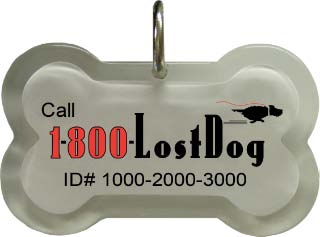 1-800-Lost
Dog Pet ID TAG - The Amazing Pet ID Tag with a Nation Wide Toll
Free Lost Dog Hotline! Not just any tag... Your pets 24/7 lifeline
to all the information needed for a fast and safe recovery. Amazing
98% Safe Recovery Record for our Member's tagged pets. Most recoveries
occur within hours and within a mile of where lost. Our double
sided tag simply reads "CALL 1-800-LostDog" along with
the Pet ID Number. Our friendly 24 hour staff collects the pet
finders information and quickly contacts the pet owner. Extensive
contact information assures we reach the pet owner quickly. Go
to
1-800-Lost
Dog Pet ID TAG - The Amazing Pet ID Tag with a Nation Wide Toll
Free Lost Dog Hotline! Not just any tag... Your pets 24/7 lifeline
to all the information needed for a fast and safe recovery. Amazing
98% Safe Recovery Record for our Member's tagged pets. Most recoveries
occur within hours and within a mile of where lost. Our double
sided tag simply reads "CALL 1-800-LostDog" along with
the Pet ID Number. Our friendly 24 hour staff collects the pet
finders information and quickly contacts the pet owner. Extensive
contact information assures we reach the pet owner quickly. Go
to  Henry:
The Feline Pen Pal Who Lends a Helping Paw
Henry:
The Feline Pen Pal Who Lends a Helping Paw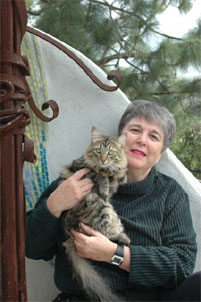
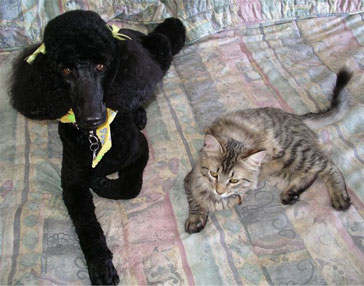
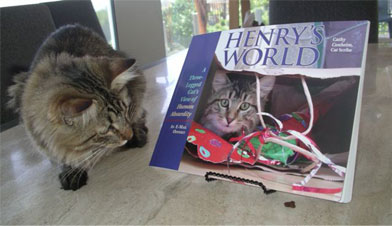 He informs me that he has already sold
more than 4,000 copies of his first book, Henry's World and nearly
1,000 of his latest book, What's the Matter with Henry? (co-authored
by Cathy Conheim and BJ Gallagher). When (not if, he tells me)
he sells 100,000 books, he would have raised one million dollars.
He informs me that he has already sold
more than 4,000 copies of his first book, Henry's World and nearly
1,000 of his latest book, What's the Matter with Henry? (co-authored
by Cathy Conheim and BJ Gallagher). When (not if, he tells me)
he sells 100,000 books, he would have raised one million dollars. * If you're a RADIO PROGRAMMER and would
like to air ANIMAL RADIO - call 435-644-5992 to get all the information
you need to begin broadcasting America's number one animal talk
show geared to listeners that like to have FUN! Animal Radio programming
is FREE for your station - and delivered via Satellite (Jones
and ABC/NY Starguide) or Compact Disc or MP3 every week.
* If you're a RADIO PROGRAMMER and would
like to air ANIMAL RADIO - call 435-644-5992 to get all the information
you need to begin broadcasting America's number one animal talk
show geared to listeners that like to have FUN! Animal Radio programming
is FREE for your station - and delivered via Satellite (Jones
and ABC/NY Starguide) or Compact Disc or MP3 every week.